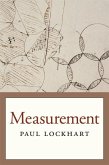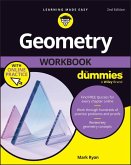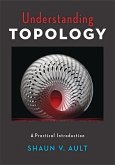Allen Hatcher (New York Cornell University)
Algebraic Topology
Allen Hatcher (New York Cornell University)
Algebraic Topology
- Broschiertes Buch
- Merkliste
- Auf die Merkliste
- Bewerten Bewerten
- Teilen
- Produkt teilen
- Produkterinnerung
- Produkterinnerung
An introductory textbook suitable for use in a course or for self-study, featuring broad coverage of the subject and a readable exposition, with many examples and exercises.
Andere Kunden interessierten sich auch für
![Topological Methods in Algebraic Geometry Topological Methods in Algebraic Geometry]() Friedrich HirzebruchTopological Methods in Algebraic Geometry43,99 €
Friedrich HirzebruchTopological Methods in Algebraic Geometry43,99 €![A First Course in Computational Algebraic Geometry A First Course in Computational Algebraic Geometry]() Wolfram DeckerA First Course in Computational Algebraic Geometry23,99 €
Wolfram DeckerA First Course in Computational Algebraic Geometry23,99 €![Measurement Measurement]() Paul LockhartMeasurement22,99 €
Paul LockhartMeasurement22,99 €![Geometry Workbook For Dummies Geometry Workbook For Dummies]() Mark Ryan (The Math Center, Winnetka, IL)Geometry Workbook For Dummies17,99 €
Mark Ryan (The Math Center, Winnetka, IL)Geometry Workbook For Dummies17,99 €![Visual Complex Analysis Visual Complex Analysis]() Tristan Needham (Professor of Mathematics Professor of MathematicsVisual Complex Analysis45,99 €
Tristan Needham (Professor of Mathematics Professor of MathematicsVisual Complex Analysis45,99 €![Mathematics is the Poetry of Science Mathematics is the Poetry of Science]() Cedric Villani (Professor, Professor, University of Lyon)Mathematics is the Poetry of Science14,99 €
Cedric Villani (Professor, Professor, University of Lyon)Mathematics is the Poetry of Science14,99 €![Understanding Topology Understanding Topology]() Shaun V. Ault (Valdosta State University Assistant Professor)Understanding Topology107,99 €
Shaun V. Ault (Valdosta State University Assistant Professor)Understanding Topology107,99 €-
-
-
An introductory textbook suitable for use in a course or for self-study, featuring broad coverage of the subject and a readable exposition, with many examples and exercises.
Hinweis: Dieser Artikel kann nur an eine deutsche Lieferadresse ausgeliefert werden.
Hinweis: Dieser Artikel kann nur an eine deutsche Lieferadresse ausgeliefert werden.
Produktdetails
- Produktdetails
- Verlag: Cambridge University Press
- Seitenzahl: 556
- Erscheinungstermin: Dezember 2001
- Englisch
- Abmessung: 176mm x 254mm x 30mm
- Gewicht: 952g
- ISBN-13: 9780521795401
- ISBN-10: 0521795400
- Artikelnr.: 10518392
- Herstellerkennzeichnung
- Libri GmbH
- Europaallee 1
- 36244 Bad Hersfeld
- gpsr@libri.de
- Verlag: Cambridge University Press
- Seitenzahl: 556
- Erscheinungstermin: Dezember 2001
- Englisch
- Abmessung: 176mm x 254mm x 30mm
- Gewicht: 952g
- ISBN-13: 9780521795401
- ISBN-10: 0521795400
- Artikelnr.: 10518392
- Herstellerkennzeichnung
- Libri GmbH
- Europaallee 1
- 36244 Bad Hersfeld
- gpsr@libri.de
Cornell University, New York
Part I. Some Underlying Geometric Notions: 1. Homotopy and homotopy type; 2. Deformation retractions; 3. Homotopy of maps; 4. Homotopy equivalent spaces; 5. Contractible spaces; 6. Cell complexes definitions and examples; 7. Subcomplexes; 8. Some basic constructions; 9. Two criteria for homotopy equivalence; 10. The homotopy extension property; Part II. Fundamental Group and Covering Spaces: 11. The fundamental group, paths and homotopy; 12. The fundamental group of the circle; 13. Induced homomorphisms; 14. Van Kampen's theorem of free products of groups; 15. The van Kampen theorem; 16. Applications to cell complexes; 17. Covering spaces lifting properties; 18. The classification of covering spaces; 19. Deck transformations and group actions; 20. Additional topics: graphs and free groups; 21. K(G,1) spaces; 22. Graphs of groups; Part III. Homology: 23. Simplicial and singular homology delta-complexes; 24. Simplicial homology; 25. Singular homology; 26. Homotopy invariance; 27. Exact sequences and excision; 28. The equivalence of simplicial and singular homology; 29. Computations and applications degree; 30. Cellular homology; 31. Euler characteristic; 32. Split exact sequences; 33. Mayer-Vietoris sequences; 34. Homology with coefficients; 35. The formal viewpoint axioms for homology; 36. Categories and functors; 37. Additional topics homology and fundamental group; 38. Classical applications; 39. Simplicial approximation and the Lefschetz fixed point theorem; Part IV. Cohomology: 40. Cohomology groups: the universal coefficient theorem; 41. Cohomology of spaces; 42. Cup product the cohomology ring; 43. External cup product; 44. Poincaré duality orientations; 45. Cup product; 46. Cup product and duality; 47. Other forms of duality; 48. Additional topics the universal coefficient theorem for homology; 49. The Kunneth formula; 50. H-spaces and Hopf algebras; 51. The cohomology of SO(n); 52. Bockstein homomorphisms; 53. Limits; 54. More about ext; 55. Transfer homomorphisms; 56. Local coefficients; Part V. Homotopy Theory: 57. Homotopy groups; 58. The long exact sequence; 59. Whitehead's theorem; 60. The Hurewicz theorem; 61. Eilenberg-MacLane spaces; 62. Homotopy properties of CW complexes cellular approximation; 63. Cellular models; 64. Excision for homotopy groups; 65. Stable homotopy groups; 66. Fibrations the homotopy lifting property; 67. Fiber bundles; 68. Path fibrations and loopspaces; 69. Postnikov towers; 70. Obstruction theory; 71. Additional topics: basepoints and homotopy; 72. The Hopf invariant; 73. Minimal cell structures; 74. Cohomology of fiber bundles; 75. Cohomology theories and omega-spectra; 76. Spectra and homology theories; 77. Eckmann-Hilton duality; 78. Stable splittings of spaces; 79. The loopspace of a suspension; 80. Symmetric products and the Dold-Thom theorem; 81. Steenrod squares and powers; Appendix: topology of cell complexes; The compact-open topology.
Part I. Some Underlying Geometric Notions: 1. Homotopy and homotopy type; 2. Deformation retractions; 3. Homotopy of maps; 4. Homotopy equivalent spaces; 5. Contractible spaces; 6. Cell complexes definitions and examples; 7. Subcomplexes; 8. Some basic constructions; 9. Two criteria for homotopy equivalence; 10. The homotopy extension property; Part II. Fundamental Group and Covering Spaces: 11. The fundamental group, paths and homotopy; 12. The fundamental group of the circle; 13. Induced homomorphisms; 14. Van Kampen's theorem of free products of groups; 15. The van Kampen theorem; 16. Applications to cell complexes; 17. Covering spaces lifting properties; 18. The classification of covering spaces; 19. Deck transformations and group actions; 20. Additional topics: graphs and free groups; 21. K(G,1) spaces; 22. Graphs of groups; Part III. Homology: 23. Simplicial and singular homology delta-complexes; 24. Simplicial homology; 25. Singular homology; 26. Homotopy invariance; 27. Exact sequences and excision; 28. The equivalence of simplicial and singular homology; 29. Computations and applications degree; 30. Cellular homology; 31. Euler characteristic; 32. Split exact sequences; 33. Mayer-Vietoris sequences; 34. Homology with coefficients; 35. The formal viewpoint axioms for homology; 36. Categories and functors; 37. Additional topics homology and fundamental group; 38. Classical applications; 39. Simplicial approximation and the Lefschetz fixed point theorem; Part IV. Cohomology: 40. Cohomology groups: the universal coefficient theorem; 41. Cohomology of spaces; 42. Cup product the cohomology ring; 43. External cup product; 44. Poincaré duality orientations; 45. Cup product; 46. Cup product and duality; 47. Other forms of duality; 48. Additional topics the universal coefficient theorem for homology; 49. The Kunneth formula; 50. H-spaces and Hopf algebras; 51. The cohomology of SO(n); 52. Bockstein homomorphisms; 53. Limits; 54. More about ext; 55. Transfer homomorphisms; 56. Local coefficients; Part V. Homotopy Theory: 57. Homotopy groups; 58. The long exact sequence; 59. Whitehead's theorem; 60. The Hurewicz theorem; 61. Eilenberg-MacLane spaces; 62. Homotopy properties of CW complexes cellular approximation; 63. Cellular models; 64. Excision for homotopy groups; 65. Stable homotopy groups; 66. Fibrations the homotopy lifting property; 67. Fiber bundles; 68. Path fibrations and loopspaces; 69. Postnikov towers; 70. Obstruction theory; 71. Additional topics: basepoints and homotopy; 72. The Hopf invariant; 73. Minimal cell structures; 74. Cohomology of fiber bundles; 75. Cohomology theories and omega-spectra; 76. Spectra and homology theories; 77. Eckmann-Hilton duality; 78. Stable splittings of spaces; 79. The loopspace of a suspension; 80. Symmetric products and the Dold-Thom theorem; 81. Steenrod squares and powers; Appendix: topology of cell complexes; The compact-open topology.









